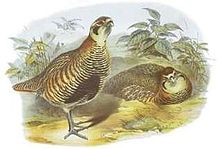
A partridge is a medium-sized galliform bird in any of several genera, with a wide native distribution throughout parts of Europe, Asia and Africa. Several species have been introduced to the Americas. They are sometimes grouped in the Perdicinae subfamily of the Phasianidae. However, molecular research suggests that partridges are not a distinct taxon within the family Phasianidae, but that some species are closer to the pheasants, while others are closer to the junglefowl.

The grey partridge, also known as the gray-legged partridge, English partridge, Hungarian partridge, or hun, is a gamebird in the pheasant family Phasianidae of the order Galliformes, gallinaceous birds. The scientific name is the Latin for "partridge", and is itself derived from Ancient Greek perdix.
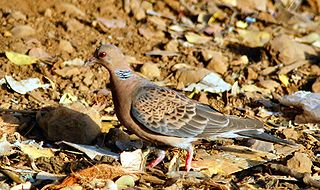
The Oriental turtle dove or rufous turtle dove is a member of the bird family Columbidae. The species has a wide native distribution range from Europe, east across Asia to Japan. The populations show variations in the patterning of plumage and have been designated into at least six named subspecies. Populations in the higher latitudes tend to migrate south in winter, while those closer to the tropics are sedentary. Vagrants have been recorded in North America. The species is predominantly granivorous and forages on the ground.

The rufous-tailed scrub robin is a medium-sized member of the family Muscicapidae. Other common names include the rufous scrub robin, rufous bush chat, rufous bush robin and the rufous warbler. It breeds around the Mediterranean and east to Pakistan. It also breeds south of the Sahara from the Sahel region east to Somalia; these African birds are sometimes considered to be a separate species, the African scrub robin. It is partially migratory, wintering in Africa and India. This is a very rare visitor to northern Europe.

The black francolin is a gamebird in the pheasant family Phasianidae of the order Galliformes. It was formerly known as the black partridge. It is the state bird of Haryana state, India.

The blood pheasant, also known as blood partridge, is the only species in genus Ithaginis of the pheasant family. It is a relatively small, short-tailed pheasant that is widespread and is fairly common in eastern Himalayas, ranging across India, Nepal, Bhutan, China, and northern Myanmar. Since the trend of the population appears to be slowly decreasing, the species has been evaluated as of least concern on the IUCN Red List in 2009.

The chestnut-collared longspur is a species of bird in the family Calcariidae. Like the other longspurs, it is a small ground-feeding bird that primarily eats seeds. It breeds in prairie habitats in Canada and the northern United States and winters to the south in the United States and Mexico.

The Tibetan sandgrouse is a large bird in the sandgrouse family. The genus name Syrrhaptes is from Ancient Greek surrhaptos, "sewn together" and tibetanus is from the type locality, Tibet.

Perdix is a genus of Galliform gamebirds known collectively as the 'true partridges'. These birds are unrelated to the subtropical species that have been named after the partridge due to similar size and morphology.

The snow partridge is a gamebird in the pheasant family Phasianidae found widely distributed across the high-altitude Himalayan regions of India, Pakistan, Nepal and China. It is the only species within its genus, and is thought to be the most basal member of the "erectile clade" of the subfamily Phasianinae. The species is found in alpine pastures and open hillside above the treeline but not in as bare rocky terrain as the Himalayan snowcock and is not as wary as that species. Males and females look similar in plumage but males have a spur on their tarsus.
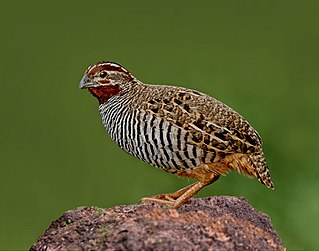
The jungle bush quail is a species of quail in the family Phasianidae. It is native to the Indian subcontinent, where it is found in peninsular India and Sri Lanka. It has also been reported from Nepal but has not been seen there since the 19th century, and an introduced population exists on the island of Réunion. A small species of quail 15–18 cm (5.9–7.1 in) long and weighing 57–82 g (2.0–2.9 oz), it shows significant sexual dimorphism. Males have brown upperparts with blackish and buff marking and whitish underparts with black barring. The face is mainly dark reddish-brown, with brown ear-coverts, a buffy-white moustachial stripe, and the supercilium turning whitish towards the back of the neck. Females have a similar pattern, but with pinkish-brown underparts, more uniform wings, and duller moustachial stripes.

The yellow-legged buttonquail is a buttonquail, one of a small family of birds which resemble, but are unrelated to, the true quails. This family is peculiar in that the females are larger and more colourful than the males and are polyandrous.

The yellow-throated sparrow or chestnut-shouldered petronia is a species of sparrow found in southern Asia.
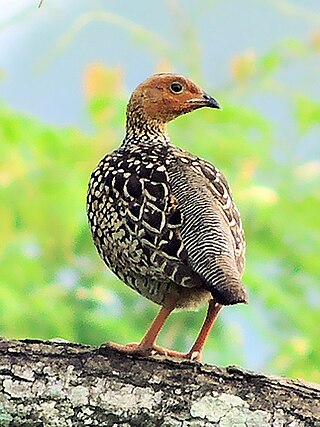
The painted francolin or painted partridge is a species of francolin found in grassy areas in central and southern India and in the lowlands of southeastern Sri Lanka. They are easily detected by their loud calls especially during the breeding season. Thomas C. Jerdon noted that the species was found mainly in Central India south of the Narmada and to the east of the Western Ghats as well as the Chota Nagpur and Northern Circars. It can be confused only with the black francolin with which it partly overlaps and is said to sometimes hybridize. This species can be told apart from a black francolin female by the lack of a rufous hind collar and the white spots on the underside. The face is rufous and there is no dark stripe running behind the eye.

The chestnut-bellied sandgrouse or common sandgrouse is a species of sandgrouse. It is a sedentary and nomadic species that ranges from northern and central Africa and further east towards western and southern Asia. There are six recognised subspecies.
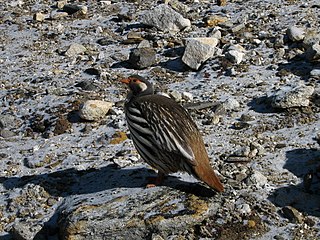
The Tibetan snowcock is a bird in the pheasant family Phasianidae of the order Galliformes, gallinaceous birds. This species is found in high-altitude regions of the Western Himalayas and the Tibetan Plateau, where it overlaps in part with the larger Himalayan snowcock. The head is greyish and there is a white crescent patch behind the eye and underside is white with black stripes. In flight the secondaries show a broad white trailing edge.

The Himalayan snowcock is a snowcock in the pheasant family Phasianidae found across the Himalayan ranges and parts of the adjoining Pamir range of Asia. It is found on alpine pastures and on steep rocky cliffs where they will dive down the hill slopes to escape. It overlaps with the slightly smaller Tibetan snowcock in parts of its wide range. The populations from different areas show variations in the colouration and about five subspecies have been designated. They were introduced in the mountains of Nevada in the United States in the 1960s and a wild population has established in the Ruby Mountains.
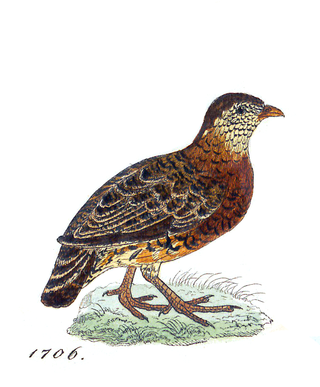
The chestnut-necklaced partridge is a species of bird in the family Phasianidae. It is found in forests in the Malay Peninsula and Sumatra. It is threatened by habitat loss and trapping. The International Union for Conservation of Nature (IUCN) has assessed it as vulnerable.

The Tibetan eared pheasant, also called Elwes' eared pheasant, is a species of bird in the family Phasianidae found in southeast Tibet and adjacent northern India, usually between 3,000 and 5,000 m elevation, but has been seen down to 2,280 m (7,500 ft) in winter.

The Tibetan blackbird is a species of bird in the thrush family Turdidae. It is found in the Himalayas from northern Pakistan to southeastern Tibet. Originally described as a separate species by Henry Seebohm in 1881, it was then considered a subspecies of the common blackbird until 2008, when phylogenetic evidence revealed that it was only distantly related to the latter species. It is a relatively large thrush, having an overall length of 23–28 centimetres. Males are blackish-brown all over with darker plumage on the head, breast, wings and tail and dull orange-yellow bills, while females have browner underparts, faint streaking on the throat, and a dull darkish yellow bill. Both sexes may seem slightly hooded. It can be differentiated from the common blackbird by its complete lack of an eye-ring and reduced song.
